Abaca fabric, derived from the resilient fibers of the abaca plant (Musa textilis), stands as a testament to nature’s ingenuity. Native to the Philippines, this sturdy natural material has earned its reputation for exceptional strength and versatility.
For centuries, abaca has been a cornerstone of industries worldwide, finding its place in maritime rigging, crafting durable ropes, and adorning homes with its rustic charm.
Its eco-friendly credentials and a rich cultural heritage of artisanal craftsmanship elevate abaca to a position of significance in both traditional and modern applications.
From handwoven textiles to industrial-grade cordage, abaca fabric continues to be a beacon of sustainable, robust elegance.
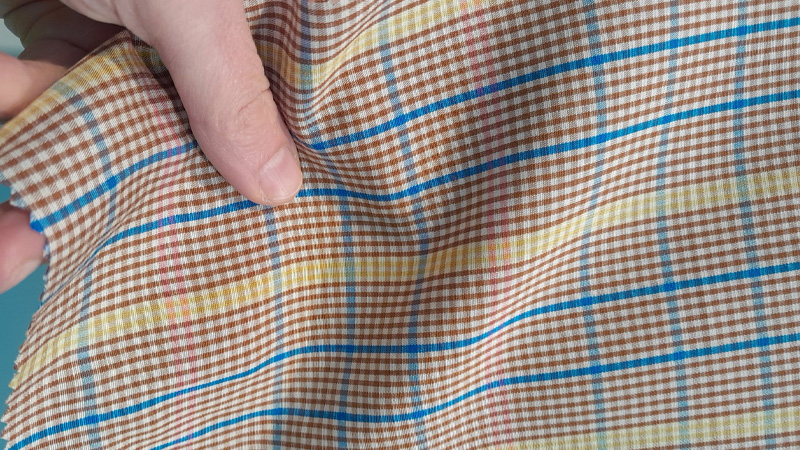
What Is Abaca Fabric?
Abaca fabric, also known as Manila hemp, is a natural fiber derived from the leaves of the abaca plant (Musa textiles).
Native to the Philippines, abaca is a species of banana plant that produces long, slender fibers known for their exceptional strength and durability.
This versatile material has been used for centuries in various industries, particularly in producing ropes, cords, and textiles.
Here are some key characteristics and applications of abaca fabric:
Natural Origin
Abaca is a renewable resource, as it is derived from a plant. It is grown in tropical regions, primarily in the Philippines and other countries with suitable climates, such as Ecuador, Costa Rica, and Indonesia.
Strength and Durability
Abaca fibers are renowned for their exceptional strength, making them one of the most potent natural fibers. This property makes abaca an excellent choice for applications where durability is crucial, such as in producing ropes, twines, and cordage.
Versatility
Abaca is a highly versatile material. In addition to ropes and cordage, it produces a wide range of products, including bags, carpets, mats, hats, and textiles.
Resistance to Moisture and Salt
Abaca fibers naturally resist moisture and salt, making them suitable for marine applications. This property has led to its widespread use in the production of ropes and nets for the shipping and fishing industries.
Eco-Friendly
Abaca is considered an environmentally friendly material. It is biodegradable and renewable, meaning it has a lower environmental impact than synthetic alternatives. Additionally, the cultivation of abaca plants helps to prevent soil erosion.
Handcrafted Artistry
Abaca fabric is often associated with traditional craftsmanship. Skilled artisans weave and manipulate the fibers to create intricate and unique designs, contributing to the cultural heritage of regions where abaca is produced.
Natural Aesthetics
Abaca fabric has a distinct natural aesthetic characterized by its coarse texture and earthy tones. This appearance lends itself well to various decor styles, from rustic to modern, and can be used in interior and exterior settings.
Challenges in Production
While abaca is a valuable natural resource, its production can face challenges. Factors such as weather conditions, pest infestations, and market demand fluctuations can impact the availability and cost of abaca fibers.
Source of Abaca Fiber
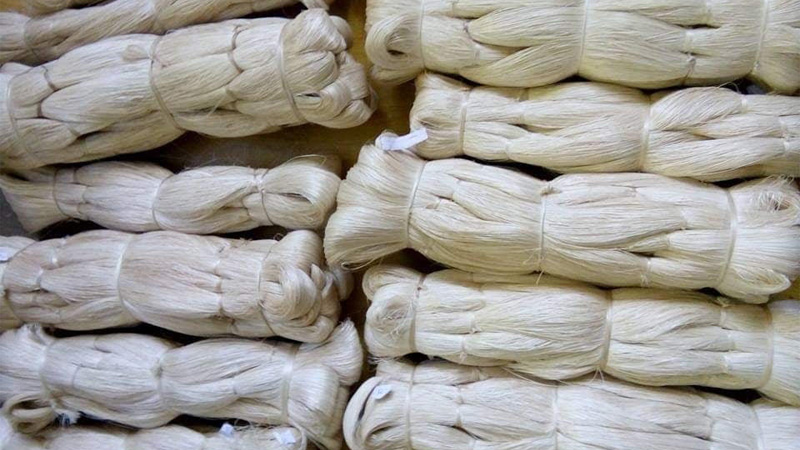
Abaca fiber is primarily sourced from the abaca plant (Musa textilis), native to the Philippines.
The Philippines has long been the world’s leading producer of abaca, and it remains the dominant source of this natural fiber.
However, other countries with suitable climates have also started cultivating abaca in recent years.
Some of these countries include:
Ecuador
Ecuador has emerged as a significant player in the abaca industry. The country’s climate, especially in coastal and lowland areas, provides an ideal environment for abaca cultivation.
Efforts have been made to improve farming practices and increase yields, contributing to Ecuador’s growing presence in the global abaca market.
The expansion of abaca production in Ecuador has bolstered the country’s economy and provided employment opportunities for local communities.
Costa Rica
Costa Rica’s tropical climate, characterized by consistent temperatures and ample rainfall, is conducive to abaca cultivation.
The country has implemented sustainable farming practices, including organic farming methods, which align with global efforts to promote eco-friendly and socially responsible production.
The growth of the abaca industry in Costa Rica has diversified the country’s agricultural sector and added a source of revenue for farmers.
Indonesia
Indonesia, known for its extensive natural resources and agricultural expertise, has diligently entered the abaca industry. The country’s tropical climate, particularly in regions like Mindanao and
Sulawesi provides favorable conditions for abaca plantations. Indonesia’s vast agricultural knowledge base has allowed for the development of efficient cultivation techniques.
As a result, the country has become an increasingly important player in the global abaca market.
Papua New Guinea
Papua New Guinea’s rich tropical environment, characterized by fertile soils and abundant rainfall, provides an excellent setting for abaca cultivation.
The country has recognized the economic potential of abaca production and has actively supported initiatives to expand its industry.
This has had positive socio-economic impacts, creating opportunities for local communities to engage in sustainable farming practices and benefit from the global demand for abaca fiber.
Production Process of Abaca Fabric
The production process of abaca fabric involves several stages, from harvesting the abaca plant to weaving the fibers into a finished textile.
Here is an overview of the typical steps involved:
Cultivation and Harvesting
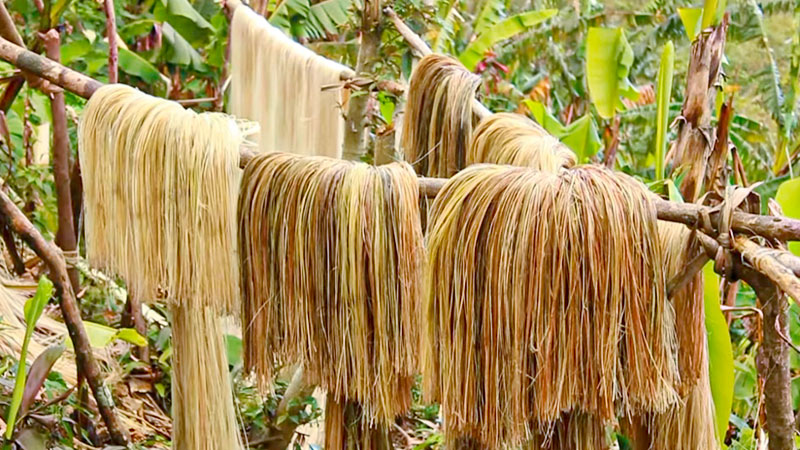
Abaca plants are grown in tropical regions, primarily in the Philippines and in countries like Ecuador, Costa Rica, Indonesia, and Papua New Guinea.
The plants are typically harvested after about 18 to 24 months when the leaves are mature and contain the highest fiber content.
Harvesting involves cutting the leaves close to the base of the plant, leaving the roots intact for regrowth.
Stripping and Decortication
Once the leaves are harvested, they are transported to a processing facility. Here, workers use sharp knives or mechanized decoration machines to strip away the outer layers of the leaves carefully. This reveals the long, fine fibers hidden within the leaf sheaths.
The decortication process requires precision to extract the maximum amount of fiber while minimizing waste.
Retting
Retting is a crucial step that softens the fibers and separates them from any remaining non-fibrous material. It can be done through two main methods: water retting and mechanical retting.
Water retting involves immersing the fibers in stagnant or flowing water, allowing natural processes to break down the gum and pectin that hold the fibers together. Depending on environmental conditions, this process may take several days to a few weeks.
Mechanical retting uses machines to mechanically agitate and separate the fibers, which tends to be faster but may require more advanced equipment.
Drying and Bleaching
After retting, the fibers are carefully laid out to dry. Sun drying is a traditional method, but mechanical dryers may be employed in modern production to speed up the process and ensure consistent drying.
In some cases, the fibers may bleach to achieve a lighter, more uniform color. This step is not always used and depends on the intended application of the abaca fabric.
Hackling and Grading
The dried and cleaned fibers are passed through a series of feathers, comb-like tools with fine metal teeth. This further separates and aligns the fibers, ensuring a more uniform and smooth texture.
The fibers are then sorted and graded based on their length, fineness, and overall quality. Higher-quality fibers are reserved for premium applications.
Spinning and Twisting
The prepared fibers are fed into spinning machines, which twist and draft into yarns. This process imparts strength to the fibers, transforming them into workable strands for weaving.
Weaving
Skilled weavers take the spun abaca yarns and use traditional hand looms or industrial weaving machines to create the final fabric. The choice of weave pattern and texture depends on the fabric’s intended use.
Finishing
Depending on the desired characteristics of the end product, the abaca fabric may undergo additional processes. This could include washing to remove residual impurities, dyeing to achieve specific colors, or coating for added strength or water resistance.
Quality Control and Inspection
The finished abaca fabric undergoes a thorough quality control process. This involves meticulous inspection to identify defects, irregularities, or inconsistencies in the weave. Any substandard material is typically discarded.
Applications of Abaca Fabric
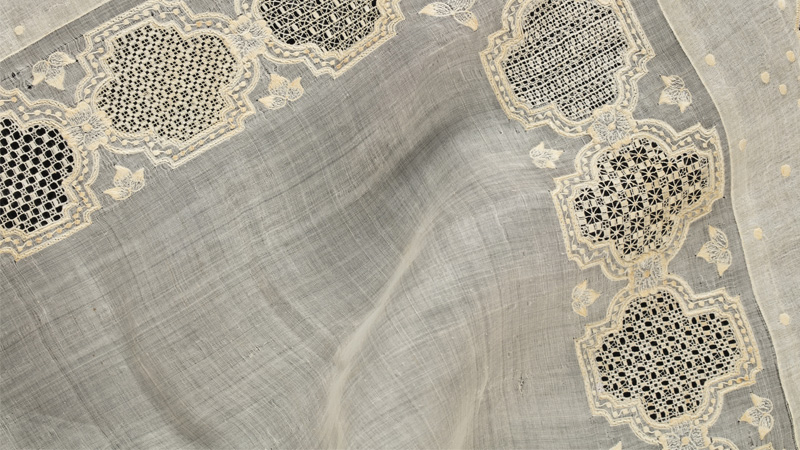
Abaca fabric, known for its exceptional strength and versatility, finds a wide range of applications across various industries.
Here are some critical uses of abaca fabric:
Ropes and Cordage
Abaca’s exceptional strength-to-weight ratio makes it indispensable in producing ropes, cords, and twines.
These abaca-based ropes are highly durable and resistant to abrasion, making them ideal for heavy-duty applications like ship rigging, construction, and climbing ropes.
Nets and Fishing Gear
Abaca’s natural resistance to water and salt makes it a preferred choice for crafting fishing nets, lines, and traps. The fibers’ durability ensures that these fishing gear withstands the harsh marine environment, contributing to successful and sustainable fishing practices.
Automotive Industry
In the automotive sector, abaca reinforces lightweight interior components like headliners and door panels. Its ability to reduce weight while maintaining strength and durability is essential for improving fuel efficiency and overall vehicle performance.
Agricultural and Garden Twine
Abaca twine is an essential tool for agricultural practices. It is used for tasks such as tying plants to trellises, staking crops, and bundling harvested produce. Its resistance to moisture and UV radiation ensures it lasts throughout the growing season.
Geotextiles and Erosion Control
Abaca-based geotextiles are crucial for controlling erosion, particularly in construction projects and landscaping. These textiles stabilize slopes, protect against soil erosion, and provide a sustainable solution for managing land erosion challenges.
Handcrafted Products
Abaca’s unique texture and durability make it a favorite material for artisans crafting various items. In the Philippines, it is used to create intricate handwoven baskets, bags, hats, and decorative mats, preserving traditional craftsmanship.
Upholstery and Home Furnishings
Abaca fabric is preferred for upholstery due to its robustness and natural aesthetic appeal. It is often used for chair seats, sofas, and cushions, lending a touch of rustic elegance to interior design.
Floor Coverings
Abaca-based carpets, rugs, and mats are prized for their resilience. Their resistance to wear and moisture makes them suitable for high-traffic areas, both in residential and commercial settings.
Fashion and Accessories
Abaca fibers are woven into fabrics used for clothing, accessories, and fashion items. Designers appreciate its versatility and eco-friendliness, creating stylish hats, bags, and garments with a natural, textured finish.
Paper Products
Abaca pulp is renowned for its long fibers, which enhance the strength and durability of paper products. It is used in specialty papers like banknotes, tea bags, and fine writing paper, where longevity and quality are paramount.
Specialized Industrial Applications
In construction and industry, abaca fibers reinforce materials like concrete and composites, enhancing structural integrity. Additionally, abaca-based filters and insulation materials offer unique benefits in specific industrial settings.
Environmental and Sustainable Products
Abaca’s eco-friendly characteristics, including its biodegradability and renewability, make it an attractive option for eco-conscious products.
It is used in sustainable packaging materials, biodegradable twine, and bio-composites, contributing to greener, more sustainable industries.
Advantages of Abaca Fabric
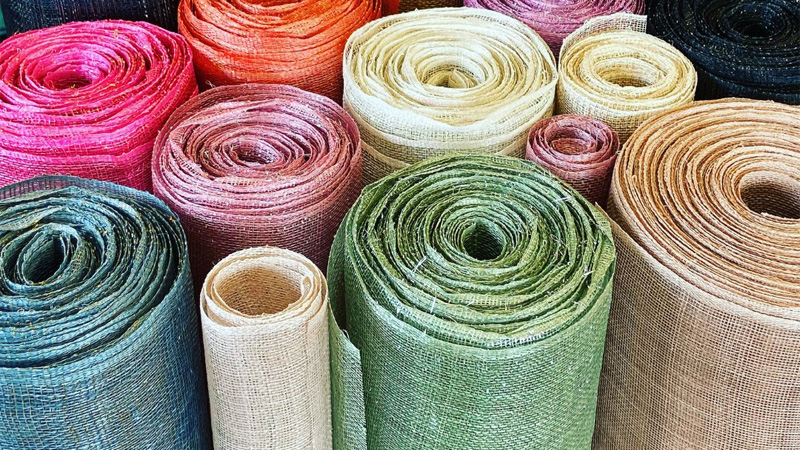
Abaca fabric offers numerous advantages and benefits, making it valuable in various industries and applications.
Here are some of the critical advantages of using abaca fabric:
Exceptional Strength
Abaca’s outstanding tensile strength surpasses many other natural fibers. This property is crucial in applications like ropes and cordage, where durability and load-bearing capacity are paramount.
Lightweight
Despite its strength, the abaca is remarkably lightweight. This characteristic is advantageous in industries like automotive manufacturing, where reducing overall vehicle weight contributes to fuel efficiency and performance.
Resistance to Moisture
Abaca’s natural resistance to moisture is invaluable, particularly in maritime environments. Unlike some synthetic alternatives, abaca fibers do not weaken or deteriorate when exposed to water, making them indispensable in marine applications.
Biodegradability
Abaca is a sustainable choice as it is biodegradable. Once discarded, it decomposes naturally, leaving behind minimal environmental impact. This contrasts with synthetic materials that can persist in landfills for extended periods.
Renewable Resource
Abaca plants are renewable and can be harvested multiple times during their lifespan. This renewable nature ensures a steady and reliable supply of raw materials without causing depletion or environmental harm.
Versatility
Abaca’s versatility allows it to be used in various applications. From traditional crafts to modern industrial uses, abaca’s adaptability to multiple industries underscores its importance as a versatile natural resource.
Resistance to Abrasion
Abaca fibers exhibit remarkable abrasion resistance, making them suitable for applications where wear and tear are expected. This quality ensures that products like ropes and upholstery endure rigorous use.
Aesthetic Appeal
Abaca fabric’s distinctive appearance, coarse texture, and earthy hues add a unique aesthetic to products. This natural, rustic charm is sought in interior design, fashion, and handcrafted items.
Cultural Significance
The production of abaca fabric often involves skilled artisans who have inherited their craft through generations. This cultural heritage contributes to the fabric’s significance and value, connecting communities to their traditions.
Reduces Soil Erosion
Abaca cultivation helps combat soil erosion, particularly in regions where it is extensively grown. The plant’s robust root system helps stabilize soil, making it a valuable component of sustainable agriculture.
Comparisons with Other Natural Fibers
Abaca fiber and other natural fibers contribute to a diverse range of materials used in various industries. Comparing abaca with other natural fibers provides insights into their strengths and applications.
Here are some comparisons with commonly used natural fibers:
Cotton
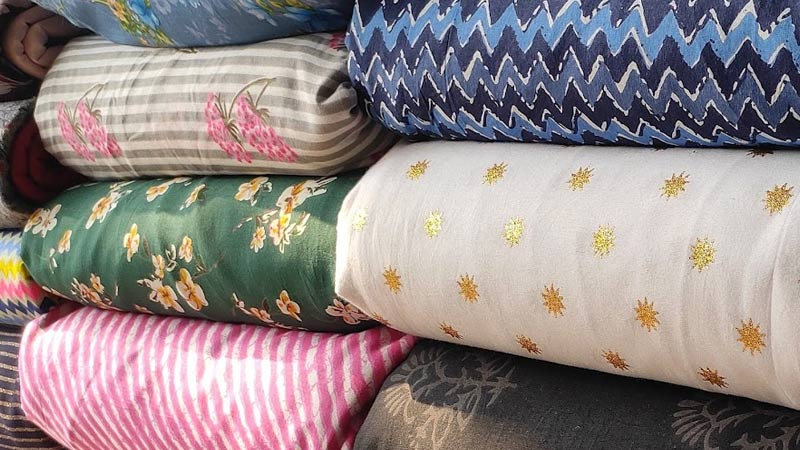
- Strength: Abaca is generally more robust than cotton, making it more suitable for high-tensile strength applications like ropes and cordage.
- Absorbency: Cotton is highly absorbent, making it a preferred choice for textiles and clothing. Abaca, on the other hand, is not as absorbent and is less commonly used in apparel.
- Cultivation: Cotton is grown in many countries with different climates, while abaca cultivation is primarily concentrated in tropical regions.
Jute
- Strength: Abaca is typically stronger than jute, making it preferable for ropes and heavy-duty packaging applications.
- Softness: Jute is softer to the touch compared to abaca, making it suitable for products like bags, rugs, and decorative items.
- Cultivation: Both abaca and jute are primarily grown in tropical climates, but jute has a broader geographical distribution.
Hemp
- Strength: Hemp fibers can be comparable to or slightly more muscular than abaca. Both are used in similar applications like ropes and textiles.
- Versatility: Hemp has a broader range of applications, including clothing, construction materials, and dietary products. Abaca is more commonly used in specialized applications like cordage and specialty papers.
Flax (Linen)
- Strength: Abaca is generally more robust than flax fibers, which makes it more suitable for heavy-duty applications like ropes and cordage.
- Appearance: Flax fibers have a smoother texture and a natural luster compared to the coarser texture of abaca.
- Cultivation: Flax is grown in temperate climates, while abaca thrives in tropical regions.
Sisal
- Strength: Abaca is typically stronger than sisal, making it preferable for demanding applications like ropes and cordage.
- Texture: Sisal fibers are coarser and less flexible than abaca, affecting their suitability for specific applications.
Bamboo
- Strength: Abaca is generally more robust than bamboo fibers, mainly when used naturally. Bamboo is often processed to increase its strength for applications like textiles and construction materials.
- Sustainability: Both abaca and bamboo are considered sustainable materials due to their renewable nature.
FAQs
What is abaca fabric?
Abaca fabric is a type of textile made from the abaca plant fibers (Musa textilis), which is native to the Philippines.
What are the critical characteristics of abaca fabric?
Abaca fabric is strong, durable, and resistant to moisture. It has a coarse texture and is typically light to medium brown, with a natural, rustic appearance.
What are the main applications of abaca fabric?
Abaca fabric is used in various applications, including ropes and cordage, fishing gear, upholstery, fashion items, handcrafted products, and specialty papers.
Is abaca fabric environmentally friendly?
Yes, abaca fabric is considered environmentally friendly because it is biodegradable and derived from a renewable resource.
Where is abaca fabric primarily produced?
The Philippines is the primary producer of abaca fabric and has a long history of cultivation and processing.
Conclusion
Abaca fabric embodies a remarkable synergy between nature’s bounty and human ingenuity. Its origins in the Philippines and its unparalleled strength have forged a legacy that spans centuries.
From maritime conquests to contemporary fashion, abaca’s versatile applications remain as diverse as the industries it serves. Its sustainable cultivation practices and biodegradability underscore its importance in an increasingly eco-conscious world.
Moreover, the intricate craftsmanship involved in its production imparts a cultural significance that transcends mere utility.
As a symbol of resilience and tradition, abaca fabric continues to weave a narrative of enduring strength and timeless elegance, ensuring its enduring relevance in our ever-evolving global landscape.
Leave a Reply